Reflections From My Art History Final Paper
I looked at the triptych and thought to myself, “why is that baby so ugly?”
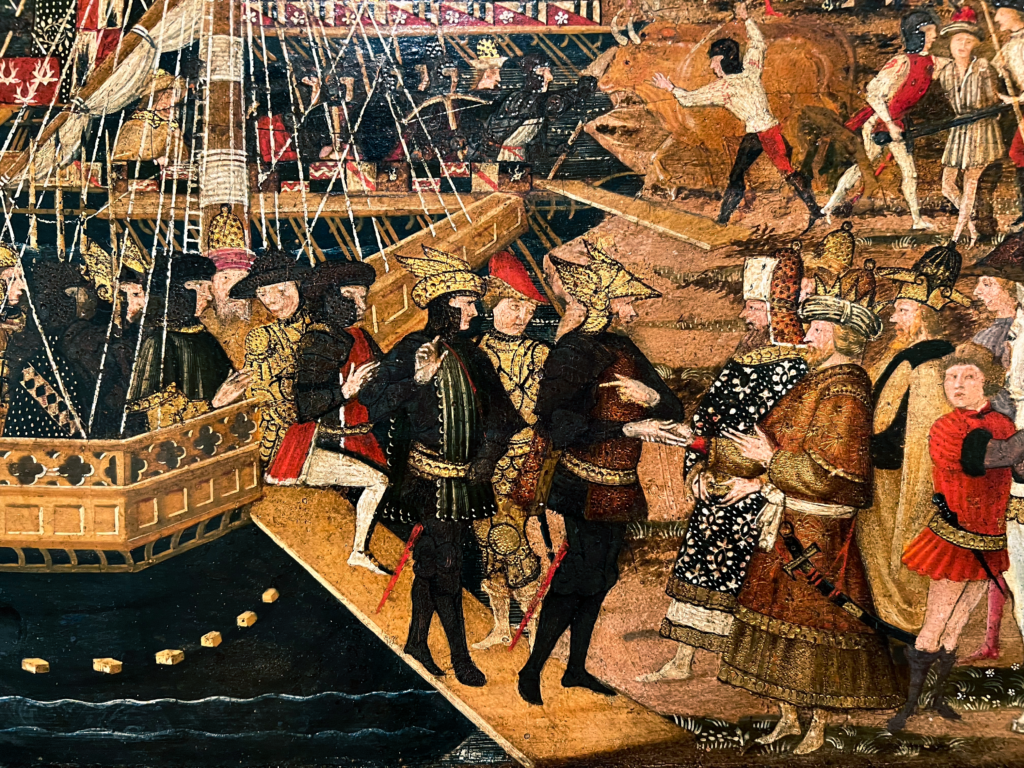
I can’t believe how quickly this year has gone by so far. Is it already mid-April? As I soon embark on an art history-focused trip to Europe, I’ve had some time to reflect upon the last quarter of Running Start. Fortunately, both classes I took involved no finals! Instead for my art history class, I was assigned a visual analysis essay. The mission, which I readily chose to accept, was to apply what I learned throughout the quarter by reviewing the artistic choices and historical context of three works in the Seattle Art Museum’s European collection.
The research process was a surprisingly delightful experience unto itself. It was early morning, the museum had just opened, and I had the entire fourth floor galleries to myself. I was all alone with the great medieval and Renaissance masterpieces. I probably should have come a bit more prepared, such as outlining what paintings I intended to research or what my paper would even be themed, yet I fondly remember the time I spent pondering these questions as rather pleasant and therapeutic. As I sat in front of Paolo Veronese’s massive Venus and Adonis, I thought about a question that had lingered in my head for so long. This was part of the many possible ideas rushing through my head for the final essay.
Why are medieval babies so ugly?
For as long as I have been enamored by the world of art history, this question has continuously permeated throughout the chaotic confines of my brain. Why are individuals, mostly babies, in Pre-Renaissance works depicted so differently than their Renaissance counterparts? Why are not only the people, but also the scenery so different? Of course, skills develop, such as linear perspective; however, medieval works are just so incredibly disparate than later Renaissance productions. It was almost as if the values of life and humanity, which radically differ between the medieval and Renaissance periods, influenced the objectives of paintings, how artists saw the world, and what they viewed as important enough to include in their works?
Sitting in that gallery all by myself, I finally found the theme, the golden ticket, I had been searching for during the past half-hour, minus the other twenty-five minutes where I had most likely succumbed to playing eye-spy with one of the Dutch still lives.
I spy with my little eye the manifestation of time and inevitable decay embedded in a sequentially degrading lemon peel which is dually pleasant to look at and a covertly boastful remark by the artist showing off their mastery of yellow paints, a difficult color to manipulate! An individual who purchased this work in a northern art market may never have either discovered the philosophical values or the secretive competition inlayed into the painting, yet a whole world of mindfulness and rivalry exist in a simple table arrangement.
I digress.
I wanted to cover each and every work in that gallery. They all told a story, they all highlighted what I learned, and they all spoke to me in a different way. But, I could only pick three. In the end, I confidently selected three works of the Italian school to highlight my analysis of artistic progression: Pietro Lorenzetti’s Virgin and Child With Saints Paul and Peter, Paolo Uccello’s Episodes From the Aeneid, and Paolo Veronese’s Venus and Adonis. What do these works have in common? Nothing. All of these works, so different in subject, skill, and objective, highlight through their very identity the tumultuous centuries of artistic development which gripped Italian painters during the Renaissance. One is a Pre-Renaissance altarpiece, heavily inspired by the restrictive iconographic palette of the Byzantine style; another is set in the dawning years of the Renaissance, as intellectuals first discovered the wonders of classical literature and were eager to parade it through all facets of culture; the third work is a Mannerist allegory which culminates all of the Renaissance developments. Instead of just constructing a mathematically perfected work, Veronese chose to instead dwell on the stories of the figures rather than the physical construction of their anatomy and the surrounding scenery.
After spending several hours in the gallery frantically and laboriously scribing notes from these paintings, I headed home and eagerly began to craft the draft of my final cumulative paper.
While this project certainly came with its set of challenges, some inherent and others superfluous, I must say I enjoyed the process of diving into the world of art history not just through the textbook, but rather through the brush and canvas of the artists’ masterpieces. I look forward to future opportunities where I can once again do the same.
Without further ado, my final paper…
The first thing I noticed when walking through the Seattle Art Museum’s European gallery (or any European gallery for that matter) was the abrupt transition from the awkwardly stiff Medieval works to the elegant and majestic Renaissance masterpieces. Between the fourteenth and seventeenth centuries, European art would experience a radical shift not only in the development of painting techniques, but also in the objectives of artistic representation. This transition from the conservative palette of the Byzantine style through the realistically grounded works of pioneering artists like Giotto to the enlightened world of the High Renaissance, was all a reflection of the important role humanistic values played in Italian art. After what humanists perceived as a dark age, Italian scholars, painters, and their patrons were eager to test drive the new ideals of humanism, which prioritized individual moral sovereignty, critical thinking (both philosophically and scientifically), and a raw fascination of the meaning of humankind. Through these three centuries, the rise of humanism would radically shift the very nature of how Italian artists saw individuals, greatly altering the way they depicted figures and the priorities behind them.
The Seattle Art Museum “connects art with life.” This short yet sweet mission statement resonates perfectly with my personal experience in the galleries. By choosing individual masterpieces for this assignment and viewing them for several minutes apiece, I could finally connect all I’ve learned this quarter. When I visited the museum, the entire fourth floor gallery was unoccupied, leaving me secluded in the dimly lit yet spotlighted room amongst the old European masterpieces. Through this isolated and extended observation, I succeeded in melding the theoretical knowledge I’ve learned with tangible visual examples found in the works.
The first work to catch my eye was Pietro Lorenzetti’s 1310-20 Virgin and Child With Saints Paul and Peter. This fourteenth-century egg-tempera-and-gold on wood triptych (three-sided altarpiece), displayed in a moderately-dim hallway connecting the European gallery with the Italian Room and Ancient Mediterranean collection, was illuminated by a loosely diffused spotlight highlighting its abundant gold foil. In the decorative, yet somewhat-abstract pre-Renaissance style, the painting features symbolized portraits of consequential Christian figures, including the Virgin Mary and an infant Christ along with saints Paul and Peter adjacent on either side.
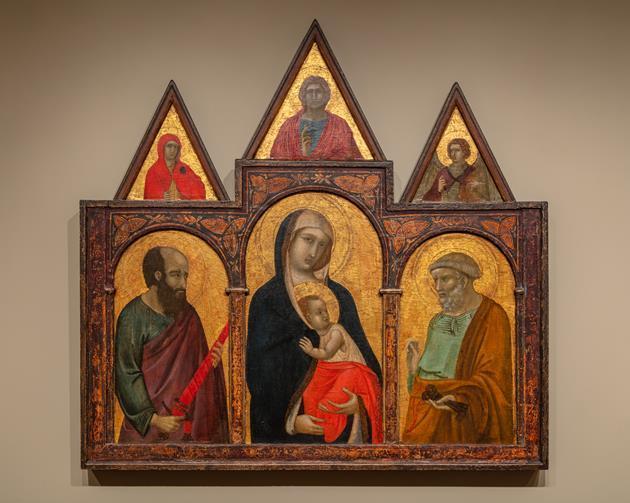
Pietro Lorenzetti, Virgin and Child With Saints Paul and Peter, 1310-20, Egg Tempera and Gold on Wood, 124.1 x 128 cm, Italian (Siena), Seattle Art Museum, Seattle. https://art.seattleartmuseum.org/objects/13596/virgin-and-child-with-saints-paul-and-peter?ctx=67cc7a4a-13b6-47a9-b97d-7e439cfd6a33&idx=0.
What really caught my attention, both academically and visually, was the shiny gold foil backing. This dually decorative and symbolic artistic choice, along with the high contrast for the defined ribbons of modeling in the figures’ garments, the gold halo backing all characters, and the two-dimensional depictions of objects like Paul’s sword and Peter’s keys (keys to kingdom of Heaven gifted to him by Christ according to SAM’s website), are all strict hallmarks of the maniera greca. Also known as the Greek, or Byzantine, style, this conservative dogma cast a deeply empathetic and emotional symbolism to religious narrative works. Dominating Italian art in the centuries predating the Renaissance, the maniera greca sought spirituality foremost in it productions, shedding all superfluous detail and placing both narrative and character in what the SAM website defines as a “divine realm”. Lorenzetti’s altarpiece wasn’t just Byzantine, though. Rather, the collection of paintings also share a strong semblance to the artistic style of Sienna, the artist’s home city. Following closely in the footsteps of the maniera greca, Sienese art experimented with new forms of decoration whilst retaining the conservative themes buttressing the maniera greca. This use of “jewel-like colors and elegantly posed figures,” according to the textbook, is acutely evident in the vivid colors of the depicted figures’ garments, their graceful poses (objectively looking past pre-Renaissance painters’ inept understanding of human form), and the majestically glimmering gold backing. Although the figures are stiff, unalive, and awkward, the technique of Lorenzetti’s painting and its callbacks to both Byzantine and Sienese tradition resulted in a work whose decorative nature compensates quite plentifully for the setbacks of pre-Renaissance figure painting.
(Close up details)
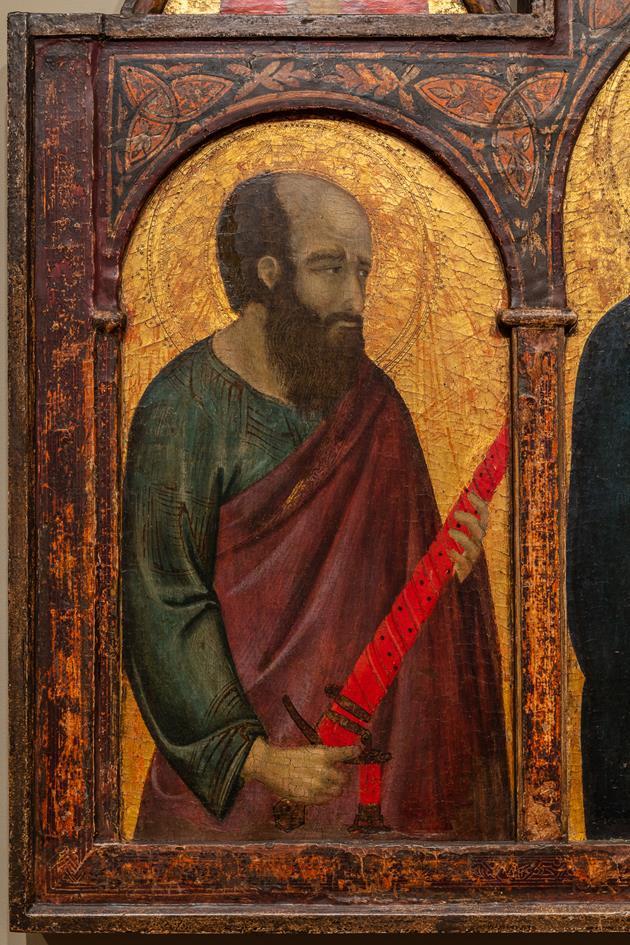
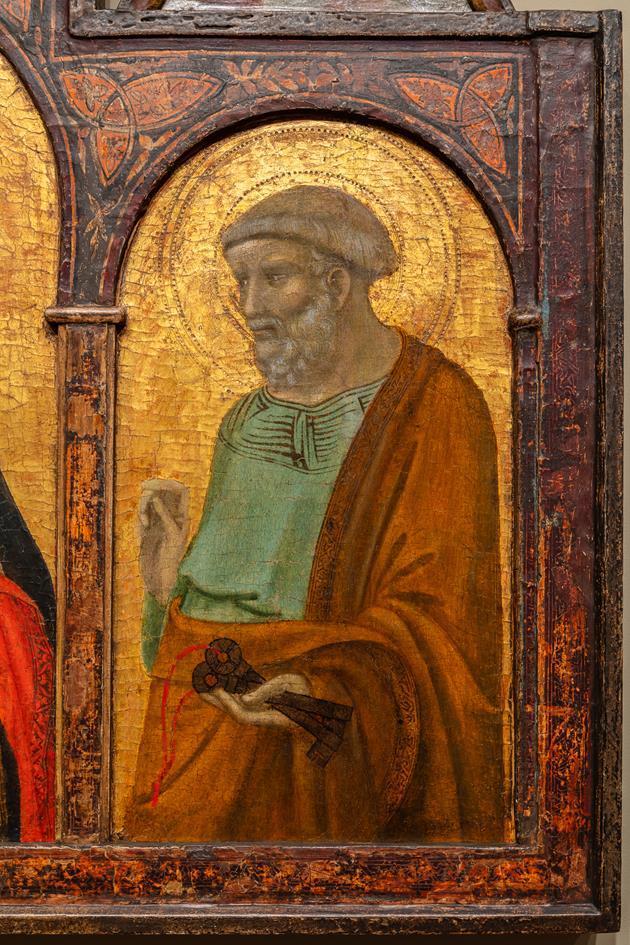
Pietro Lorenzetti, Virgin and Child With Saints Paul and Peter, 1310-20, Egg Tempera and Gold on Wood, 124.1 x 128 cm, Italian (Siena), Seattle Art Museum, Seattle. Both images from https://art.seattleartmuseum.org/objects/13596/virgin-and-child-with-saints-paul-and-peter?ctx=67cc7a4a-13b6-47a9-b97d-7e439cfd6a33&idx=0.
While in the gallery, I spent over 20 minutes observing the countless details of this painting, from the two-dimensional sword and key to the almost Norse-like ribbon tracing in the frame of the triptych. However, what persistently lingered in my head was the symbolism of the painting’s composition. The Seattle Art Museum website described the gold backing of this work, and the composition of Byzantine art in general, as a “divine realm.” Unlike the humanistically-centered, yet still religious works, produced in the later Renaissance, like Perugino’s Giving the Keys to St. Peter, Lorenzetti’s work is devoid of action. Peter already has the keys to heaven while Christ is still in infancy (Christ gives Peter the keys according to SAM’s website). Alternately, Paul holds the very sword he was beheaded with. To add insult to injury, none of these characters depicted (except for Mary), even reside in the same time period. According to the Seattle Art Museum’s website, Paul never interacted with Jesus nor Mary, and Peter and Jesus only first met when they were both in adulthood. Instead of aligning with the later humanists and composing a realistically grounded Christian story, Lorenzetti has instead chosen to remove these characters from their natural world (highlighted through the gold backing) and condense them into a singular spiritual realm. In totality, this Byzantine-inspired masterpiece does not feature the actions of a Christian-themed event, but rather constructs a symbolic snapshot of the church itself. Mary and her son Jesus are at the center, both physically and spiritually, while the founders of the Christian Church, Saints Paul and Peter, flank the infant Christ. These figures, lacking true-life and truncated into a theologically metaphysical space, highlight the objectives of Pre-renaissance Italian Art and its reliance on symbolism before the origins of humanism.
The rise of humanism would turn the Lorenzetti’s era upside down. In the fourteenth century, a revolution of new ideas and priorities would flourish in Italy, becoming what we know today as the Renaissance. While a new generation of artists, like Giotto de Bondone, worked towards crafting paintings set in a realistically anchored world teeming with three-dimensional solidity, Italian writers and scholars began to obsessively study the natural world, revere classical civilizations, write literature, analyze concepts critically, and seek to answer the apex question: “what does it mean to be human?” Paolo Uccello’s painting, Episodes From the Aeneid, is a perfect snapshot of this bold new world’s rise. Akin to many of the contemporary artist Giotto’s works, like Marriage at Cana, Raising of Lazarus, Lamentation, and Resurrection, Uccello’s masterpiece emphasizes the technical skill being developed in Italy through its realism while simultaneously showcasing the spiritual revolution through its embodiment of classical themes, comparable to works like Botticelli’s Birth of Venus. The 1470 masterpiece is displayed in the Italian Room, with two intersecting diffused spotlights, and depicts several scenes from the Roman epic, the Aeneid.
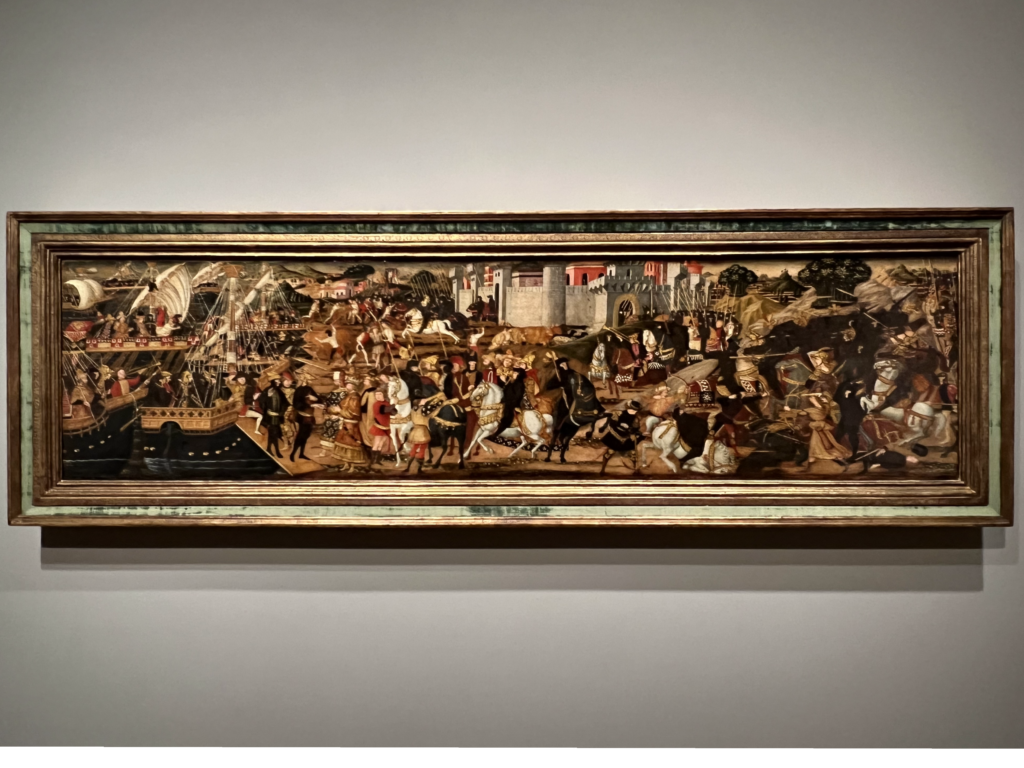
Paolo Uccello, Episodes From the Aeneid, 1470, Egg Tempera, Oil, and Gold on Wood Panel, 41 x 156.2 cm, Italian (Florence), Seattle Art Museum, Seattle. https://art.seattleartmuseum.org/objects/13945/episodes-from-the-aeneid;jsessionid=FF211B165D48BE2610386AC815E763ED.
As I sat observing the painting, I began to notice more, and more, and more details. Like the genuine realm conceived through Giotto’s brush, Uccello’s painting is set in a perceivably real world. Through his skillful blend of egg tempera, oil paints, and gold (all on wood), the artist was able to compose every detail of a space grounded in depth and familiarity. Rather than the abstract gold backgrounds of Lorenzetti’s altarpiece, bereft of tangible space and scenery, Episodes From the Aeneid features renderings of trees, hills, galleons, the ripples around them, plants, dirt, and even a castle in the background. The castle is not just added detail; it rather provides a specific location for the unfolding scene. Through these details, Uccello has set this painting in not just a realistic world, but also in our own native world. Unlike the maniera greca, where static narratives were spoon fed through pre-existing religious knowledge, Uccello’s scene allows the viewer to decrypt the meaning and conceive a palpable sense of action. This is in stark contrast to Lorenzetti’s work. Christ is an infant while surrounded by two adult apostles. One holds the key later gifted to him by the infant Christ while the other holds the sword responsible for his own death. The painting has no story. It is rather a snapshot of Christian beliefs. The sole narrative comes from the life of Christ, which is not recalled in the composition but already known by its viewers in advance. While Virgin and Child With Saints Paul and Peter features no beginning nor end to a non-existent story, Episodes From the Aeneid boasts a world full of action, intrigue, and plot. Beginning the vignette on the left-hand side, the trojan Aeneas is being greeted by the hospitable King Evander. Further to the right, a battle ensues between Aeneas’ troops and the local Rutulian soldiers, where Evander’s son Pallas is killed. After this battle, Aeneas requests one-on-one combat with the enemy leader Turnus, but he is intercepted by Turnus’ ally Camila. This lifelike world, and its classically centered focus, fits itself perfectly into the puzzle of the early Italian Renaissance. Out was the Byzantine influence; in was Giotto and similar artists’ realism.
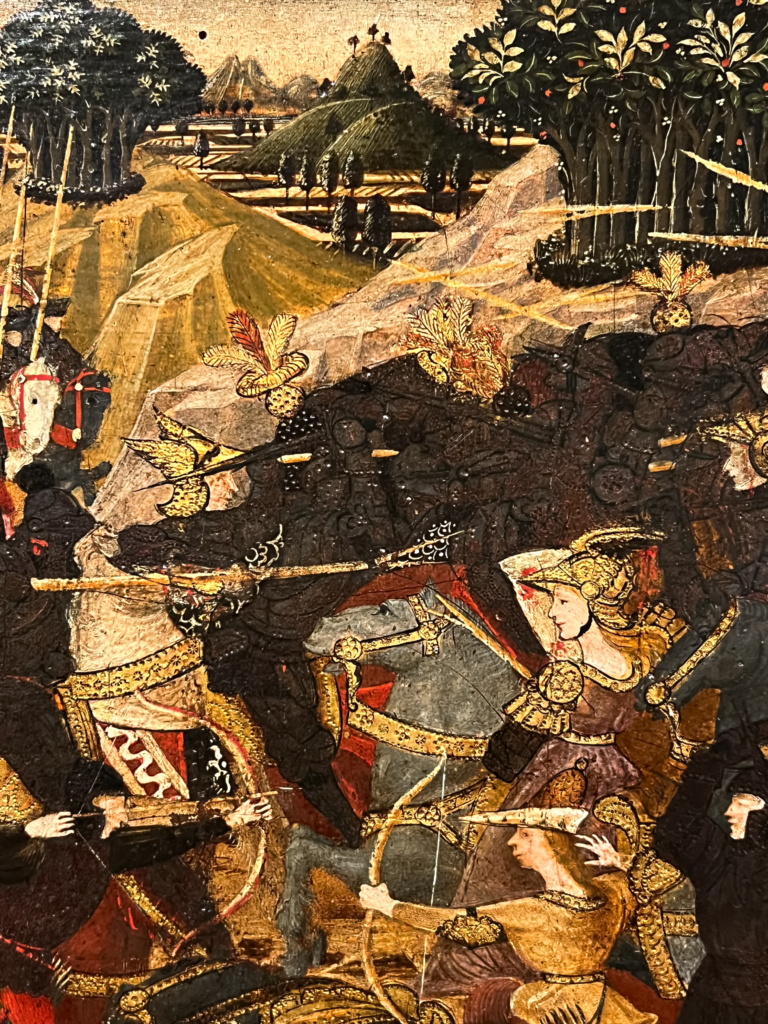
(Close up details)
Paolo Uccello, Episodes From the Aeneid, 1470, Egg Tempera, Oil, and Gold on Wood Panel, 41 x 156.2 cm, Italian (Florence), Seattle Art Museum, Seattle. Photo taken by Zachary Lundgren.
Although the world of Italian art began to favor realism in the fourteenth century, wonderfully seen in Episodes From the Aeneid, there was still a long journey ahead. While Uccello’s masterpiece renders the world in a believable manner, shedding the restrictive symbolism of the previous Byzantine influences, there is a predominant lack of linear perspective. I noticed this in the lower left-hand corner, where the plank of the main galleon fails to line up appropriately with the surrounding space. While Uccello’s work stresses the technical and scholarly shifts of the humanists, such as the embracement of classical themes and a critically realistic depiction of the world through art, it still lacks some of the mathematical developments discovered during this period. Around the same time as Uccello, artists like Masaccio and Brunelleschi would succeed in pioneering linear perspective, a mathematically constant ratio for receding space. While Uccello’s Episodes From the Aeneid may not be perfect in its technical skill, the artist helped turn the table on the lifeless symbolism and spiritual realms of the maniera greca, instead favoring to deliver the world as if it was our own.
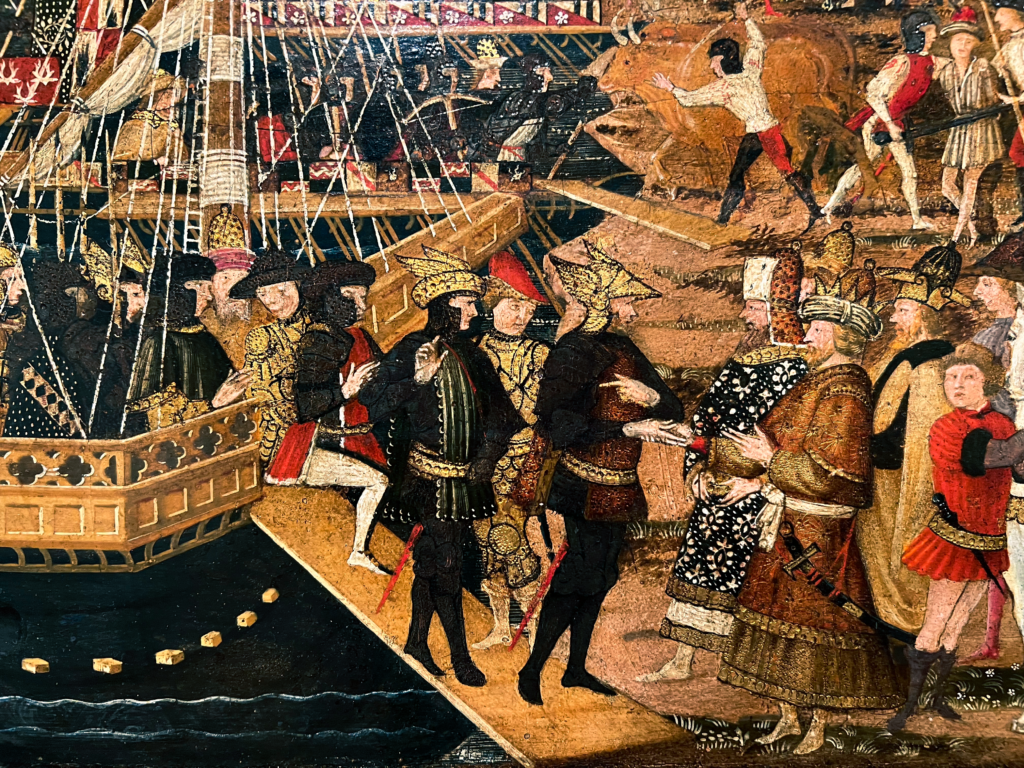
(Close up detail) Paolo Uccello, Episodes From the Aeneid, 1470, Egg Tempera, Oil, and Gold on Wood Panel, 41 x 156.2 cm, Italian (Florence), Seattle Art Museum, Seattle. Photo taken by Zachary Lundgren.
There is no work in the Seattle Art Museum’s collection as staggering as Paolo Veronese’s Venus and Adonis. This monumental 1570s oil on canvas painting, illuminated by two diffused spotlights, is hung directly adjacent to the Porcelain Room in the main room of the European gallery. This majestic painting depicts a snapshot of the relationship between the classical goddess Venus and her mortal lover, the hunter Adonis. Already playing on the allegorical themes of Venus and Adonis’ love, Veronese’s use of minute details and vibrant colors to depict the kinetic forms and almost-knotted postures of the two lovers instantly recalls the bold, expressive palette of the mannerist movement. The large canvas marks the culmination of the humanists’ endeavor, first through the painting’s realistic portrayal and setting, the illustration of human emotions, and finally its entrance into expressive qualities and allegorical stories of passion.
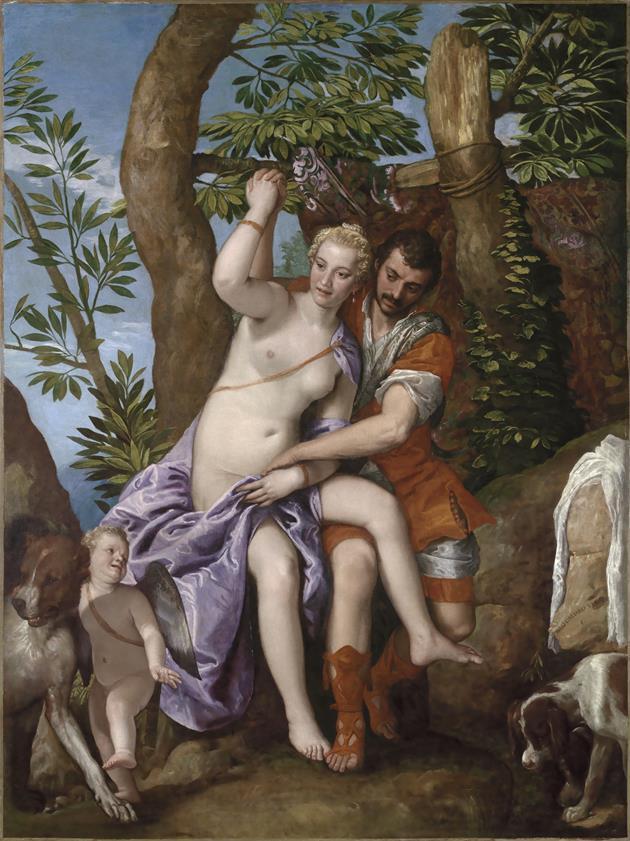
Paolo Veronese, Venus and Adonis, 1570s, Oil on Canvas, 224.4 x 168.3 cm, Italian, Seattle Art Museum, Seattle. https://art.seattleartmuseum.org/objects/13949/venus-and-adonis.
All of these visual attributes of Venus and Adonis are fierce hallmarks of Mannerism. In lieu of the rational perfectionism of the High Renaissance, Italian artists began to dabble in certain virtues (as the textbook describes) such as “artificiality, grace, and elegance.” This new expressive quality soon expanded into a rejection of the classical ideals of perfectionism and proportionalism (21.4: Mannerism). These artists, known as Mannerists, would now prioritize elegantly disproportional and exaggerated forms all articulating the concepts of passion, grace, and allegory. All of these traits can easily be observed in Veronese’s masterpiece. Through the artist’s bold painting choices, the figures of Venus and Adonis are caught in a love-fueled passion of loosely knotted forms molded together perfectly. The colors are also vivid, such as Venus’ strewn garments and Adonis’ bright orange clothes. Primarily though, the scene is an allegory on love. After being shot by one of Cupid’s arrows, the goddess Venus abruptly falls in love with the moral hunter Adonis. However, through their romance, they both lose their inherent qualities: Venus, the goddess of beauty, now lives a life in the rugged outdoors while Adonis gives up the hunt. However, this passion would quickly conclude when Adonis returns to hunting and is unexpectedly killed by a boar. Analogous to the other Mannerists, who chose to infuse what The Collector describes as “highly charged, emotive subjects,” Veronese has chosen to forgo the High Renaissance priority on perfected human anatomy and has instead shown Venus and Adonis in favor of a dramatically elegant yet chaotic flux of emotion and love. While this work may not be as exaggerated and audacious as other Mannerist works, like Bronzino’s vividly colored and philosophically charged Allegory With Venus and Cupid, Venus and Adonis is still a solid contribution to Mannerism. Through Veronese’s use of allegorical themes of emotion rather than studies on perfected and proportional forms, we can observe the final transition in the metamorphosis of Italian Art. Through the values of humanism, art has finally reached the era’s apex of dual realism and emotive expressionism, far beyond the contributions of either Lorenzetti or Uccello.
From Lorenzetti to Veronese, these works showcase a snapshot of the revolutionary developments in Italian art. Over these three centuries, from 1300 to 1600, not just the technique of painting developed, but so did the objectives of art. While Lorenzetti lived in a Byzantine world, where religious empathy and emotive divinity stifled any developments in technique or narrative, Uccello and Veronese did not. Uccello was of the generation that saw the new possibilities in art, choosing instead to paint the world as it was and to promote plot and action rather than spaceless, timeless, and lifeless profiles. By shedding the maniera greca, art was finally allowed to feel alive. That wasn’t the end though. Through the humanists’ constant questions on the meaning of humanity, Mannerists like Veronese took the stage to unveil new objectives for painting. Instead of just rendering the world as it was and striving to achieve realistic perfection, art instead became theatrical and dramatic, an idealized fiction. All because of the humanists, who persistently imagined a world of education, critical thought, and new ways of expression, Italian art was able to evolve in its core priorities and objectives.
Sources:
- Stokstad, Marilyn and Michael W. Cothren. “Art History.” Pearson, 1/19/2017.
- “Episodes From the Aeneid.” Seattle Art Museum, https://art.seattleartmuseum.org/objects/13945/episodes-from-the-aeneid;jsessionid=FF211B165D48BE2610386AC815E763ED.
- “Virgin and Child With Saints Paul and Peter.” Seattle Art Museum, https://art.seattleartmuseum.org/objects/13596/virgin-and-child-with-saints-paul-and-peter?ctx=2aeb7150-9b1c-4e5e-ac4f-f24c92134816&idx=0.
- “Venus and Adonis.” Seattle Art Museum, https://art.seattleartmuseum.org/objects/13949/venus-and-adonis.
- Cartwright, Mark. “Renaissance Humanism.” World History Encyclopedia, 04 November 2020, https://www.worldhistory.org/Renaissance_Humanism/.
- Lesso, Rosie. “What Does Mannerist Art Look Like?” The Collector, 14 September 2022, https://www.thecollector.com/what-does-mannerist-art-look-like/.
Please note that in-text citations have been removed for this post.